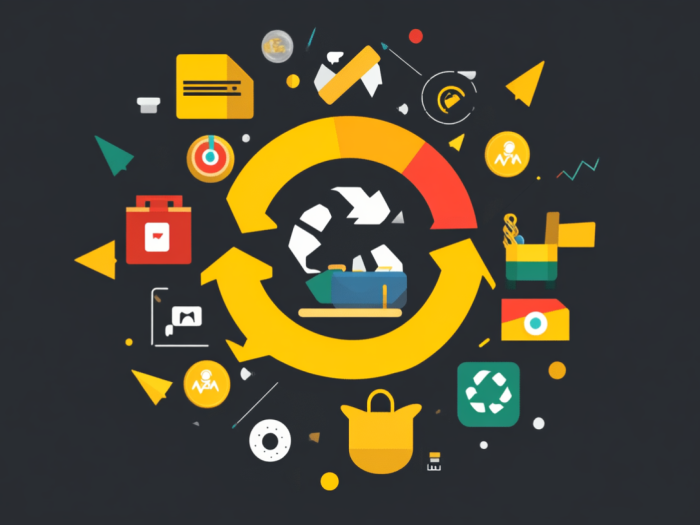The circular economy, focused on reducing waste and maximizing resource utilization, is
creating exciting investment opportunities. Companies that are transforming waste into
profit are at the forefront of this shift. This article explores the top circular
economy stocks with strong growth potential.
Understanding the Circular Economy
The circular economy is a model of production and consumption that involves sharing,
leasing, reusing, repairing, refurbishing, and recycling existing materials and products
for as long as possible. It contrasts with the traditional linear economy, which follows
a “take-make-dispose” approach.
Benefits of the Circular Economy
- Reduced Waste: Minimizes landfill waste and pollution.
- Resource Efficiency: Conserves valuable resources.
- Economic Growth: Creates new business models and jobs.
- Innovation: Drives innovation in recycling and reuse technologies.
Sectors Driving the Circular Economy
Several sectors are crucial to the circular economy:
-
Recycling and Waste Management: Companies that collect, process, and
recycle waste materials. - Renewable Energy: Companies that produce energy from renewable sources like solar and wind.
- Sustainable Packaging: Companies developing eco-friendly packaging solutions.
- Remanufacturing: Companies that refurbish and resell products.
- Sharing Economy: Platforms that facilitate sharing resources like cars or tools.
Top Circular Economy Stocks
(Disclaimer: This information is for educational purposes only and should not be
considered financial advice. Stock performance is subject to market fluctuations.
Conduct thorough research before investing.)
1. Waste Management (WM)
Waste Management is a leading provider of waste management, recycling, and resource
recovery services.
-
Circular Economy Focus:
- Recycling and waste-to-energy initiatives.
- Focus on landfill gas utilization.
-
Growth Potential:
- Increasing demand for recycling and waste management.
- Expansion into sustainable waste solutions.
2. Republic Services (RSG)
Republic Services is another major player in the waste management and recycling industry.
-
Circular Economy Focus:
- Recycling programs and landfill gas projects.
- Investment in renewable energy from waste.
-
Growth Potential:
- Rising demand for recycling services.
- Focus on sustainability initiatives.
3. (Add 8 more detailed examples here. Be sure to research and add specific data and detailed descriptions for each company.)
potential.
- Renewable energy
- Electric vehicle battery recycling
- Sustainable packaging
- Water treatment and reuse
- Textile recycling
Factors to Consider
-
Innovation: Companies developing innovative recycling or reuse
technologies. -
Scalability: Companies with business models that can be scaled to meet
growing demand. -
Regulatory Support: Government policies and regulations that promote the
circular economy. -
Consumer Awareness: Increasing consumer demand for sustainable products
and services.
Risks of Investing in Circular Economy Stocks
-
Technological Change: Rapid technological advancements can disrupt the
industry. -
Competition: The circular economy is attracting new players, increasing
competition. -
Regulatory Uncertainty: Changes in regulations can impact the
profitability of some circular economy businesses.
Conclusion
Investing in circular economy stocks offers a way to participate in a growing trend that
addresses environmental challenges and creates economic opportunities. By carefully
selecting companies with strong business models and innovative solutions, investors can
potentially generate attractive returns while contributing to a more sustainable future.
Related Keywords
Circular economy stocks, sustainable investing, waste management stocks, recycling
stocks, renewable energy stocks, sustainable packaging stocks, circular economy
companies, investing in sustainability, green stocks, ethical investing.
Frequently Asked Questions (FAQ)
1. What is the circular economy?
The circular economy is a model of production and consumption that focuses on
sharing, reusing, repairing, refurbishing, and recycling existing materials and
products.
2. How does the circular economy differ from the linear economy?
The circular economy contrasts with the traditional linear economy, which
follows a “take-make-dispose” approach, generating significant waste.
3. What are the benefits of the circular economy?
Benefits include reduced waste, resource efficiency, economic growth, and
innovation.
4. What sectors are driving the circular economy?
Key sectors include recycling and waste management, renewable energy,
sustainable packaging, remanufacturing, and the sharing economy.
5. Are waste management companies part of the circular economy?
Yes, waste management companies play a crucial role in the circular economy
through recycling and resource recovery.
6. What is remanufacturing?
Remanufacturing involves refurbishing and reselling products, extending their
lifespan and reducing the need for new production.
7. What are some of the trends to watch in the circular economy?
Trends include advancements in recycling technologies, the development of
bio-based materials, and the expansion of sharing economy platforms.
8. What are the risks of investing in circular economy stocks?
Risks include rapid technological change and increased competition.
9. Is the circular economy a long-term trend?
Yes, the circular economy is considered a long-term trend driven by
environmental concerns and the need for sustainable resource management.
10. Can investing in the circular economy be financially rewarding?
Yes, investing in the circular economy offers the potential for financial
rewards as well as positive environmental impact.



